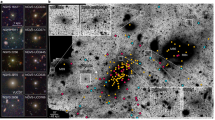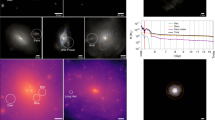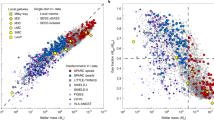Abstract
Dwarf spheroidal galaxies are the most dark-matter-dominated systems in the nearby Universe1,2,3 and their origin is one of the outstanding puzzles of how galaxies form. Dwarf spheroidals are poor in gas and stars, making them unusually faint4,5,6, and those known as ultra-faint dwarfs7,8 have by far the lowest measured stellar content of any galaxy9,10. Previous theories11 require that dwarf spheroidals orbit near giant galaxies like the Milky Way, but some dwarfs have been observed in the outskirts of the Local Group12. Here we report simulations of encounters between dwarf disk galaxies and somewhat larger objects. We find that the encounters excite a process, which we term ‘resonant stripping’, that transforms them into dwarf spheroidals. This effect is distinct from other mechanisms proposed to form dwarf spheroidals, including mergers13, galaxy–galaxy harassment14, or tidal and ram pressure stripping, because it is driven by gravitational resonances. It may account for some of the observed properties of dwarf spheroidals in the Local Group. Within this framework, dwarf spheroidals should form and interact in pairs, leaving detectable long stellar streams and tails.
This is a preview of subscription content, access via your institution
Access options
Subscribe to this journal
Receive 51 print issues and online access
$199.00 per year
only $3.90 per issue
Buy this article
- Purchase on Springer Link
- Instant access to full article PDF
Prices may be subject to local taxes which are calculated during checkout




Similar content being viewed by others
References
Kleyna, J. T., Wilkinson, M. I., Evans, N. W., Gilmore, G. & Frayn, C. Dark matter in dwarf spheroidals – II. Observations and modeling of Draco. Mon. Not. R. Astron. Soc. 330, 778–791 (2002)
Chapman, S. et al. Keck DEIMOS kinematic study of Andromeda IX: dark matter on the smallest galactic scales. Astrophys. J. 632, L87–L90 (2005)
Wilkinson, M. I. et al. Kinematically cold populations at large radii in the Draco and Ursa minor dwarf spheroidal galaxies. Astrophys. J. 611, L21–L24 (2004)
Mateo, M. Dwarf galaxies of the Local Group. Annu. Rev. Astron. Astrophys. 36, 435–506 (1998)
Grebel, E. K. in The Stellar Content of Local Group Galaxies (eds Whitelock, P. & Cannon, R.) 17–38 (IAU Symposium 192, Astronomical Society of the Pacific, 1999)
Gallagher, J. S., Madsen, G. J., Reynolds, R. J., Grebel, E. K. & Smecker-Hane, T. A. A search for ionized gas in the Draco and Ursa Minor dwarf spheroidal galaxies. Astrophys. J. 588, 326–330 (2003)
Willman, B. et al. A new Milky Way dwarf galaxy in Ursa Major. Astrophys. J. 626, L85–L88 (2005)
Zucker, D. B. et al. A new Milky Way dwarf satellite in Canes Venatici. Astrophys. J. 643, L103–L106 (2006)
Peñarrubia, J., Navarro, J. F. & McConnachie, A. The tidal evolution of Local Group dwarf spheroidals. Astrophys. J. 673, 226–240 (2008)
Strigari, L. E. et al. A common mass scale for satellite galaxies of the Milky Way. Nature 454, 1096–1097 (2008)
Mayer, L., Kazantzidis, S., Mastropietro, C. & Wadsley, J. Early gas stripping as the origin of the darkest galaxies in the Universe. Nature 445, 738–740 (2007)
Grebel, E. K., Gallagher, J. S. & Harbeck, D. The progenitors of dwarf spheroidal galaxies. Astrophys. J. 125, 1926–1939 (2003)
Toomre, A. in The Evolution of Galaxies and Stellar Populations (eds Tinsley, B. M. & Larson, R. B.) 401–426 (Yale University Observatory, 1977)
Moore, B., Katz, N., Lake, G., Dressler, A. & Oemler, A. Galaxy harassment and the evolution of clusters of galaxies. Nature 379, 613–616 (1996)
Bullock, J., Kravtsov, A. & Weinberg, D. H. Reionization and the abundance of galactic satellites. Astrophys. J. 539, 517–521 (2000)
Dekel, A. & Silk, J. The origin of dwarf galaxies, cold dark matter, and biased galaxy formation. Astrophys. J. 303, 39–55 (1986)
Mac Low, M. M. & Ferrara, A. Starburst-driven mass loss from dwarf galaxies: efficiency and metal ejection. Astrophys. J. 513, 142–155 (1999)
Gnedin, O. Y., Hernquist, L. & Ostriker, J. P. Tidal shocking by extended mass distributions. Astrophys. J. 514, 109–118 (1999)
Sales, L., Navarro, J. F., Abadi, M. G. & Steinmetz, M. Cosmic menage a trois: the origin of satellite galaxies on extreme orbits. Mon. Not. R. Astron. Soc. 379, 1475–1483 (2007)
Lynden-Bell, D. Dwarf galaxies and globular clusters in high velocity hydrogen streams. Mon. Not. R. Astron. Soc. 174, 695–710 (1976)
Libeskind, N. I. et al. The distribution of satellite galaxies: the great pancake. Mon. Not. R. Astron. Soc. 363, 146–152 (2005)
Zentner, A. R., Kravtsov, A. V., Gnedin, O. Y. & Klypin, A. A. The anisotropic distribution of galactic satellites. Astrophys. J. 629, 219–232 (2005)
D'Onghia, E. & Lake, G. Small dwarf galaxies within larger dwarfs: why some are luminous while most go dark. Astrophys. J. 686, L61–L64 (2008)
Tully, R. B. et al. Associations of dwarf galaxies. Astron. J. 132, 729–748 (2006)
Toomre, A. & Toomre, J. Galactic bridges and tails. Astrophys. J. 686, L61–L64 (1972)
Ferguson, H. C. & Binggeli, B. Dwarf elliptical galaxies. Annu. Rev. Astron. Astrophys. 6, 67–122 (1994)
Penny, S., Conselice, C., De Rijcke, S. & Held, E. V. Hubble Space Telescope survey of the Perseus Cluster – I: The structure and dark matter content of cluster dwarf spheroidals. Mon. Not. R. Astron. Soc. 393, 1054–1062 (2009)
Klypin, A., Kravtsov, A. V., Valenzuela, O. & Prada, F. Where are the missing galactic satellites? Astrophys. J. 522, 82–92 (1999)
Moore, B. et al. Dark matter substructure within galactic halos. Astrophys. J. 524, L19–L22 (1999)
Rines, K. & Geller, M. J. Spectroscopic determination of the luminosity function in the galaxy clusters A2199 and Virgo. Astrophys. J. 135, 1837–1848 (2008)
Acknowledgements
This research was partly supported by an EU Marie Curie Intra-European Fellowship under contract MEIF-041569 and by an NSERC postgraduate fellowship. Numerical simulations were performed on the Odyssey supercomputer at Harvard University.
Author Contributions E.D. designed and led the study and analysis, ran the simulations, and wrote the paper; G.B. was involved in study design and contributed to text writing; T.J.C. designed the initial condition programs; and L.H. was involved in study design and contributed to text writing.
Author information
Authors and Affiliations
Corresponding author
Supplementary information
Supplementary Information
This file contains Supplementary Methods, Supplementary Data, Supplementary Figures 1- 9 with Legends and Supplementary References. (PDF 285 kb)
Rights and permissions
About this article
Cite this article
D'Onghia, E., Besla, G., Cox, T. et al. Resonant stripping as the origin of dwarf spheroidal galaxies. Nature 460, 605–607 (2009). https://doi.org/10.1038/nature08215
Received:
Accepted:
Issue Date:
DOI: https://doi.org/10.1038/nature08215
This article is cited by
-
The Magellanic Corona as the key to the formation of the Magellanic Stream
Nature (2020)
-
Toward an Internally Consistent Astronomical Distance Scale
Space Science Reviews (2017)
-
Comments on the final evolutionary phase of very small dwarf spheroidal galaxies
Astrophysics and Space Science (2010)
Comments
By submitting a comment you agree to abide by our Terms and Community Guidelines. If you find something abusive or that does not comply with our terms or guidelines please flag it as inappropriate.



